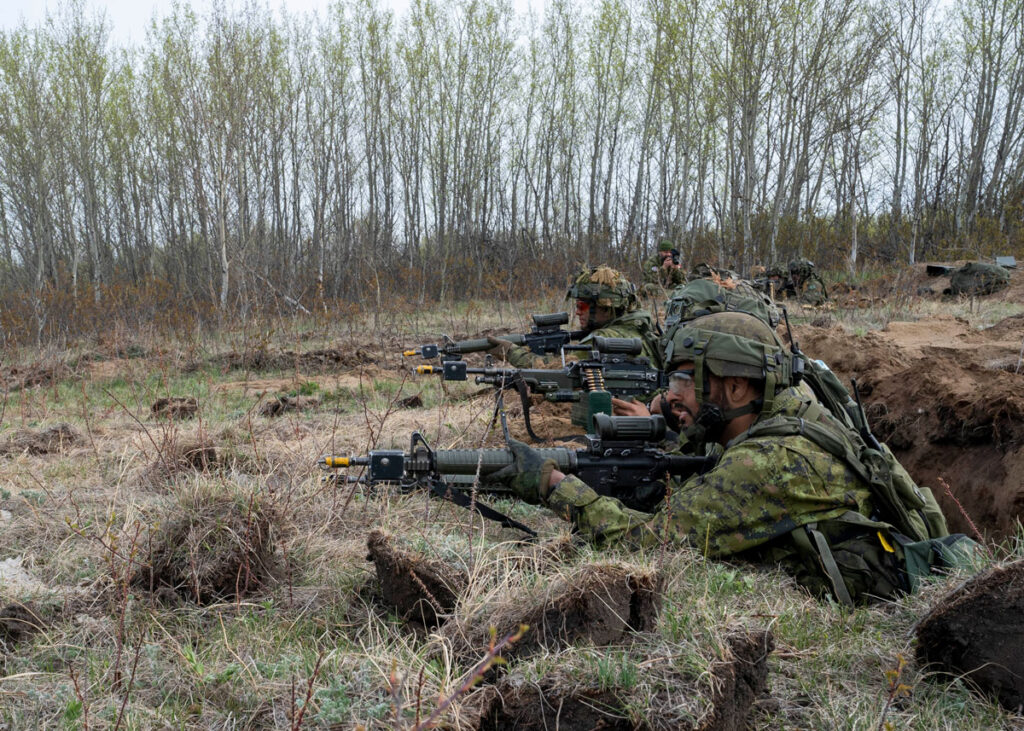An interview with RAdm Jeff Zwick, Chief of Combat Systems Integration
In anticipation of the 9th annual C4ISR and Beyond conference taking place on January 26th in Ottawa. The conference brings Canadian Armed Forces, Defence, Allies, Government and Industry leaders and collaborators together – motivated by the need for and requirement to truly deliver leading capabilities to our men and women in uniform and to the missions they serve.
Vanguard reached out to VAdm Jeff Zwick, the Chief of Combat Systems Integration, who leads the newly established CSI, to share with us the focus of the organization and the changing nature of pan-domain warfare.

Now that the Chief of Combat Systems Integration has been formally stood-up, can you describe the role, functions, and focus areas of the organisation?
- CCSI is a new Level 2 organisation that reports directly to the Vice Chief of Defence Staff (VCDS) and works closely and in parallel with the other two key Level 2 organisations: Chief of Program, and Chief of Force Development. It was established to lead, on behalf of the Chief of Defence Staff (CDS), the horizontal integration work necessary to make the Canadian Armed Forces fit for purpose for 21st century operations. To achieve this, our two principal focus areas are bringing military coherence to the supply chain and the creation of a Pan Domain Command and Control (PDC2) system that will enable military leaders to make better informed operational decisions at the speed of relevance. We approach this through three key lenses, with a directorate established for each that provide focus and horsepower to address some key priorities of the CDS. These three Directorates are Director Military Digital Operations, Director Operational Sustainment, and Director Joint Integration.
- We have made some great progress in all three of these areas. The CAF Digital Campaign Plan was released by the CDS earlier this year, and it frames the CAF approach to Digital Transformation. It has been followed by the VCDS Digital Transformation Directive, which directs the implementation of that Campaign Plan and provides tasks and resources to all elements of the CAF, and to some key departmental enablers such as ADM Materiel, ADM Information Management (now called DND Chief Information Office), ADM Data, Innovation and Analytics (now called Digital Transformation Office) and ADM Defence Research and Development Canada.
- As you are of course aware, the Joint Intelligence, Surveillance, and Reconnaissance Future Operating Concept was released this summer by the VCDS. The goal of this document is to provide a conceptual and intellectual guide in order to harmonize and synchronize force development across all environments, enabling the efficient introduction of new technologies and systems that are aligned and integrated to create a joint capability. In addition, this document outlines some of the Horizon 0-1 initiatives and steps in the near term that will set us on a vector to achieving a digital JISR capability that is truly joint.
- The Operational Sustainment Modernisation (OSM) Strategy has also been released by the CDS. The OSM Strategy is a capstone document considered as part of the CAF’s modernization and reconstitution efforts. The OSM Strategy is a joint Force Development initiative that outlines the imperatives for a paradigm shift within the CAF’s Sustainment Enterprise and to transform it, in accordance with Canada’s Defence Policy, “Strong, Secure, Engaged”. Future operating environments will require the full integration of sustainment effects to generate persistent readiness advantages and win the fight. Two key drivers for the development of the strategy were the evolving CAF/allied Pan-Domain Command and Control concept, and the digital transformation efforts through the Defence Resource Business Modernization (DRBM) programme.
- So, as you can see, we have been busy! We have made some great strides in advancing some key CDS priorities in a very short period of time, through concerted and concentrated effort. Now that we have established the intellectual and professional framework to get after Digital, Sustainment, and Joint Integration, we will shift our focus to implementation, which is where we will start to bear the fruit of our labours.
What do you consider to be the key cross-cutting capability that will enable C4ISR?
- C4ISR is ultimately about linking sensors to effectors at a speed and accuracy that delivers a decision advantage over an adversary. In many ways, we should longer be considering what sensors we need, and what platforms they need to be mounted on. It should be about what data do we need to inform decisions. And the links between sensors and effectors need a technical foundation that “carries” a data fabric, which is accessed by applications to turn situational awareness into decisions, and decisions into effects.
- What I just described is the conceptual model of Pan Domain Command and Control (PDC2), and it is PDC2 that enables and defines our approach to C4ISR. Ultimately, this is what the operational outcome of Digital Transformation will look like. So “Digital” is the key cross-cutting capability. It is so important that the VCDS is in fact the CAF Digital Champion
- Any discussion of a digital must start with a firm understanding of the centrality of data to this journey. Data are a strategic commodity and must be treated as such. Our ability to leverage data as an enterprise depends on data management, as well as a shift in culture and mind-set to view and treat data as a shared asset. Without enterprise-wide attention to the foundations of data, DND / CAF will not be able to realize the potential of data to drive enhanced capabilities—both in operational and corporate contexts
- To highlight the importance of operational data to achieving a decision advantage over our adversaries, on behalf of the VCDS, CCSI will be appointed as the steward of the Operational Data Domain. We will issue firm direction on data standards that will ensure fundamental interoperability not only within the CAF, but also with our Allies and partners. We have to get the data right. It must be trusted, accurate, and valued. That will require robust stewardship. Data must also be agnostic to platforms or applications, and data-based interoperability will become a critical High Level Mandatory Requirement for all future projects.

We often hear of the imperative to digitally transform. How would you describe that imperative?
- At its very simplest, the imperative can be boiled down to credibility. Can we deliver operational and institutional effects that are credible to our strategic and national leadership, our Allies, the Canadian people, and indeed our own people within the Defence Team?
- The digital revolution, powered by the strategic lever that aggregated data represents, will continue around us, whether we embark upon our own digital journey or not. Our adversaries and competitors will continue to improve their capabilities, and our Allies will continue to evolve and change. The Digital FVEY will be based on the language of data, and the culture of digital. If we don’t learn the language, and we don’t adopt the culture, we may well find ourselves on the outside looking in. We must stay apace with our Allies, and ahead of our adversaries.
- Failure to undergo a Digital Transformation will entail existential risk to the CAF, and substantial programmatic and reputational risk to the Department. From the institutional perspective, the imperative is about delivering our corporate requirements in an accurate and transparent manner, allowing us to improve the reinvestment of resources through data informed strategic decision making. Operationally, the digital imperative is about gaining a decision advantage over our adversaries. We gain that advantage with a C2 system that is integrated, trusted, aggressively decentralised, and enables holistic risk awareness through complete integration with and access to institutional data and information. That C2 system must be completely interoperable with our Allies, while serving institutional requirements for transparency and openness. We cannot achieve that unless we transform.
- As the CDS has said, “the CAF must transform. And transform we shall. We will not simply incorporate Digital – we will become Digital”.
How has the changing character of warfare influenced the need to achieve true Joint Integration within the CAF?
- Much of the discussion of the evolving character of warfare has focused on the response to below the threshold conflict. Our foundational documents that discuss operating in a pan-domain environment, clearly identify that we are in an era of dangerous competition, and that Canada’s adversaries offer a concerted and sustained challenge to the international rules-based order. We face a continued state of competition, confrontation and, potentially, conflict. This means that we must adapt to these changes, and see the world as it is, and view it through the lens of matrix of completion rather than a linear spectrum of conflict.
- Our adversaries are challenging us in the cyber and space domains as well as in the traditional land, maritime, and air domains. Therefore, we must be able to meet this challenge across all domains simultaneously.
- Recent conflicts in Syria and Ukraine have clearly demonstrated that large scale and above the threshold conflict is still a threat, and moreover have shown how even a modest overlay of digital capabilities can disrupt decades-old operational concepts and change the character of war. The prevalence of cyber activities, drone technology, sensor-to-effectors linkages and autonomous systems has changed the battlefield into a more digital space. In all cases, the ability to exploit a technological advantage exposed the critical vulnerabilities of forces that were static, massed, or lacked defensive countermeasures.
- These changes to the character of war mean that we must review our own capabilities and consider how the CAF can achieve an operational advantage over our adversaries. We must update our concepts of conflict to effectively compete, contest, confront, or if necessary, combat a range of opponents that are diverse, dispersed, digitally enabled, and increasingly sophisticated.
- Key then to evolving our response to the changing character of warfare will be to leverage the digital to improve our ability to sense, make sense, decide, and act. It will allow greater integration of operational effects, even as the complexity of the operating environment is increasing dramatically.
- We will do that through the development of the PDC2 concept, which is essentially the Canadian version of the US Joint All Defense Command and Control project, or the UK Multi-Domain Integration Program.
- This highlights the importance of maintaining interoperability within NORAD, FVEYs, and NATO. Our key drivers to ensure this interoperability will be a full embrace of the NATO Federated Mission Networking (FMN) program. All that we do must be FMN compliant. Full FMN adoption will not only ensure alignment but will also provide the impetus to evolve our technology and processes at the speed of our key Allies.
- This pragmatic approach of leveraging in-flight programs that are firmly rooted in interoperability at the data and technological layer will drive greater integration across the Joint Team within the CAF and maintain our interoperability with our Allies.
Any final closing thoughts?
• We are at a historical inflection point, where operational digital capabilities will directly influence success or failure on the battlefield. As the CDS indicated, the CAF cannot undertake digital transformation alone, and we will rely on support from the dedicated teams of uniformed members, public servants, contractors, academia, and industry that compromise the broader Defence Team in order to deliver, when required, the operational success that Canadians expect and deserve.

